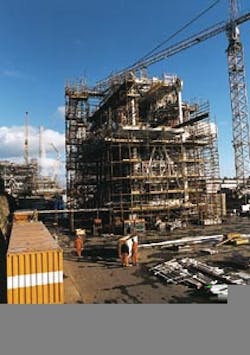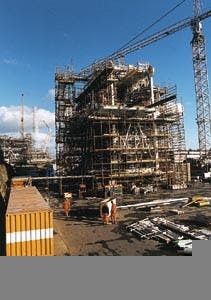PRODUCTION ENGINEERING J-block partners salvage production through tacked-on gas injection module
Enron Europe was the spanner in the works. All gas reserves in the J-block area of North Sea Quad 30, housing Judy, Joanne and numerous other discoveries, were contracted to Enron under a long-term sales agreement. However, in September 1995, as the project approached fruition, Enron sprang a surprise by declining to take deliveries until September of this year.
High Court action was instituted by the J-block partners, but this would not resolve their imminent dilemma, that liquids production was bound up with the associated gas. Reinstating gas injection - an idea rejected earlier in the development - was the only real alternative.
Costs of this unexpected add-on were not as bad as they might appear. The partners budgeted $82 million for the scheme, including the installation. As Judy version I had come in 15% below budget at ?767 million, the accountants could not complain. Besides, the new module would be designed to boost hydrocarbons recovery by 5% or more.
As is the norm lately in the UK North Sea, the schedule had to be tight to deliver injection, and consequently first oil, by spring 1997. Kvaerner Oil & Gas set to work on the detail design shortly after Enron's bombshell, completing the study in April 1996. The previous month Amec in Wallsend, UK, which had built the Judy topsides, began fabricating the new module. This and the compressor, from Nuovo Pignone in Italy, had to be ready by early December 1996 in the lead-up to installation on the platform later that month by Saipem crane barge S7000.
Planning ahead
With so many prospective satellites in the J-block area, the Judy platform had always been designed to house extra facilities, such as water injection: the gas injection module's dry weight of 700 tonnes would be well within the topsides capacity. The platform's east face was the chosen location, adjacent to the wellbay.Key equipment on the module, aside from the knockout drum and cooler, is the gas compressor and its driver, which will inject 200 million cf/d via an injection manifold on the platform connected to three injection wells. The driver is a GE aero engine: the light weight compensates for the extra thick pipework needed to handle gas from the reservoir at pressures up to 7,000 psi.
When contracts were issued, Nuovo Pignone recommended its current compressor design to speed delivery. Completion of this consignment last October (in slightly under a year) was quick for a gas turbine-driven unit, according to project manager Peter Williams. However, his team aided the process by waiving the 12 weeks of tests normally performed at the manufacturer's works.
Instead, numerous Phillips officials conducted a full engineering audit at Nuovo Pignone's Florence site, evaluating test results from over 85 compressors. As no complications were noted, the risks of instability or vibration that would be induced by the Judy compressor were considered minimal. The team decided therefore to save time and expense by completing tests of the unit offshore.
The finished compressor (the package weighs 105 tons in total) was one of Nuovo Pignone's largest ever forgings: within the module, it is integrated with a centralized safety system and a distributed control system. A local equipment room was also placed on the module to facilitate onshore testing and minimize offshore hook-up (performed by Grootcon). Instruments were tested in Wallsend, but one task that had to be left to the offshore stage was a thorough workover of the pipes and vessels with a nitrogen-helium mix to ensure that there are no gas leaks.
During normal operation, the compressor engine will be driven by gas from the export compressors on the platform. Ideally, the engine will be serviced twice a year, at a time that coincides with general platform maintenance.
Dimensions of the gas injection module are 19 meters long, generally 7.5m wide and 17.3m high, although height rises to 24.5m when the module support frame (MSF) is added. Operational weight will be 800 tons - not exactly a severe challenge for a giant crane barge to manipulate, but the J-block partners had valid reasons for selecting the S7000.
Chief among these were the weather in the central North Sea in late December. S7000, which can lift in dynamic positioning mode, was considered the best candidate. Prior to installation, hang-off frames were pre-installed on the Judy topsides with pins and location pockets to guide the MSF and module into position and accept the varying loads.
The completed module was due to be loaded onto a barge mid-December for onward transport to Rotterdam. There it was to be transferred to the S7000, which would sail to the platform and install the module within a three-day weather window. Operating conditions for this exercise were set at 9 meters/sec wind and 2-3 m waves maximum.
If all goes to plan, injection will start in April, allowing the platform to finally issue oil through the Norpipe system at 30-40,000 b/d. Around 2 bcf of gas has already been produced: in November, Enron declared its intention to take 300 million cf/d for a few weeks to prove that the platform could produce at this rate and that Enron's facilities in Teesside could process these quantities.
But Enron's future intentions remain unclear. It appears now to be giving zero estimates for Judy/Joanne gas right up to end-September 1998. Unless the J-block partners can resolve the dispute legally, they may be stuck with liquids production of less than half the original target of 95,000 b/d. There are also uncontracted gas reserves waiting to be developed in an adjoining block as well as further nearby prospects to be drilled, such as Jenny and Josephine.'
Copyright 1997 Offshore. All Rights Reserved.

